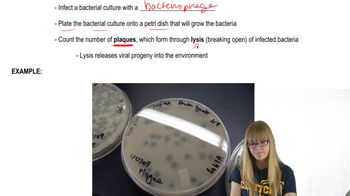What functional information about a genome can be determined through applications of chromatin immunoprecipitation (ChIP)?
Table of contents
- 1. Introduction to Genetics51m
- 2. Mendel's Laws of Inheritance3h 37m
- 3. Extensions to Mendelian Inheritance2h 41m
- 4. Genetic Mapping and Linkage2h 28m
- 5. Genetics of Bacteria and Viruses1h 21m
- 6. Chromosomal Variation1h 48m
- 7. DNA and Chromosome Structure56m
- 8. DNA Replication1h 10m
- 9. Mitosis and Meiosis1h 34m
- 10. Transcription1h 0m
- 11. Translation58m
- 12. Gene Regulation in Prokaryotes1h 19m
- 13. Gene Regulation in Eukaryotes44m
- 14. Genetic Control of Development44m
- 15. Genomes and Genomics1h 50m
- 16. Transposable Elements47m
- 17. Mutation, Repair, and Recombination1h 6m
- 18. Molecular Genetic Tools19m
- 19. Cancer Genetics29m
- 20. Quantitative Genetics1h 26m
- 21. Population Genetics50m
- 22. Evolutionary Genetics29m
15. Genomes and Genomics
Functional Genomics
Problem 17c
Textbook Question
A 2-kb fragment of E. coli DNA contains the complete sequence of a gene for which transcription is terminated by the rho protein. The fragment contains the complete promoter sequence as well as the terminator region of the gene. The cloned fragment is examined by band shift assay. Each lane of a single electrophoresis gel contains the 2-kb cloned fragment under the following conditions:
Lane 1: 2-kb fragment alone
Lane 2: 2-kb fragment plus the core enzyme
Lane 3: 2-kb fragment plus the RNA polymerase holoenzyme
Lane 4: 2-kb fragment plus rho protein
Explain the relative positions of bands in lanes 1 and 4.
 Verified step by step guidance
Verified step by step guidance1
Step 1: Understand the experimental setup. The band shift assay is used to study protein-DNA interactions. In this experiment, the 2-kb DNA fragment is analyzed under different conditions to observe how proteins interact with the DNA and affect its mobility during electrophoresis.
Step 2: Analyze Lane 1. This lane contains the 2-kb DNA fragment alone, without any proteins. Since no protein is bound to the DNA, the fragment will migrate based on its size and charge alone, serving as the reference position for comparison with other lanes.
Step 3: Analyze Lane 4. This lane contains the 2-kb DNA fragment plus rho protein. Rho protein binds to the terminator region of the DNA, forming a DNA-protein complex. This complex is larger and has altered charge properties compared to the unbound DNA, causing it to migrate more slowly during electrophoresis.
Step 4: Compare the relative positions of bands in Lane 1 and Lane 4. The band in Lane 4 will appear higher (closer to the origin) on the gel compared to Lane 1 because the DNA-rho complex has reduced mobility due to its increased size and altered charge.
Step 5: Conclude the significance of the band shift. The difference in band positions between Lane 1 and Lane 4 confirms that rho protein binds specifically to the terminator region of the DNA fragment, demonstrating its role in transcription termination.
 Verified video answer for a similar problem:
Verified video answer for a similar problem:This video solution was recommended by our tutors as helpful for the problem above
Video duration:
3mPlay a video:
Was this helpful?
Key Concepts
Here are the essential concepts you must grasp in order to answer the question correctly.
Transcription and RNA Polymerase
Transcription is the process by which RNA is synthesized from a DNA template. RNA polymerase is the enzyme responsible for this process, and it exists in two forms: the core enzyme, which can synthesize RNA but cannot initiate transcription, and the holoenzyme, which includes a sigma factor that allows it to bind to promoters and initiate transcription. Understanding how these enzymes interact with DNA is crucial for analyzing the results of the band shift assay.
Recommended video:
Rho-Dependent Termination
Rho-dependent termination is a mechanism by which the rho protein facilitates the termination of transcription in prokaryotes. Rho binds to the RNA transcript and moves along it, eventually causing the RNA polymerase to dissociate from the DNA when it reaches a specific termination site. This concept is essential for understanding why the presence of rho protein in lane 4 affects the position of the bands in the gel.
Recommended video:
Guided course

Translation Termination
Electrophoresis and Band Shift Assay
Electrophoresis is a technique used to separate nucleic acids based on their size and charge. In a band shift assay, the binding of proteins (like RNA polymerase or rho) to DNA can alter the mobility of the DNA fragment during electrophoresis, resulting in different band positions. Analyzing the relative positions of bands in lanes 1 and 4 helps to determine the effects of protein binding on the DNA fragment.
Recommended video:
Guided course

Plaques and Experiments
Related Videos
Related Practice
Textbook Question
578
views



